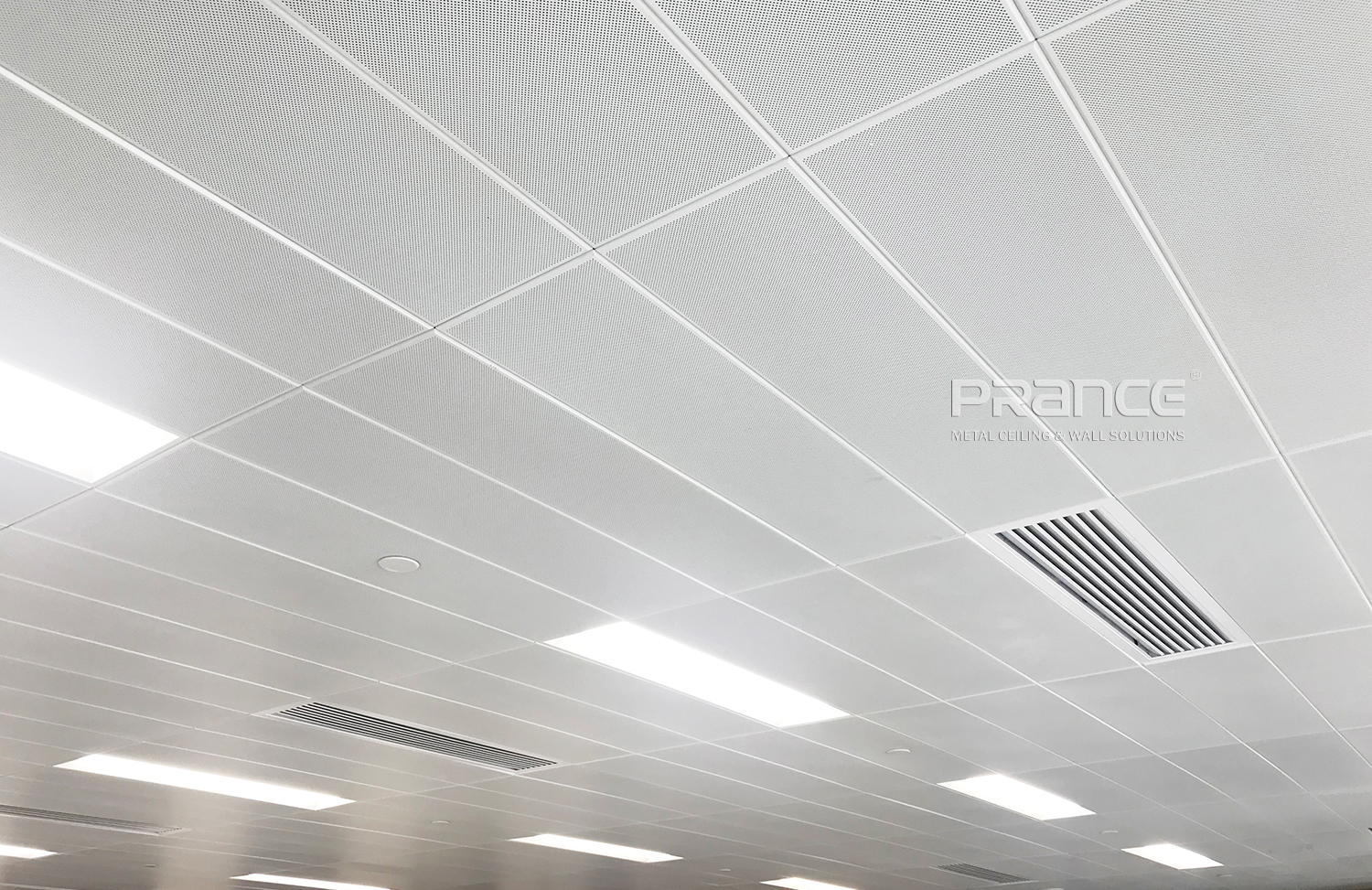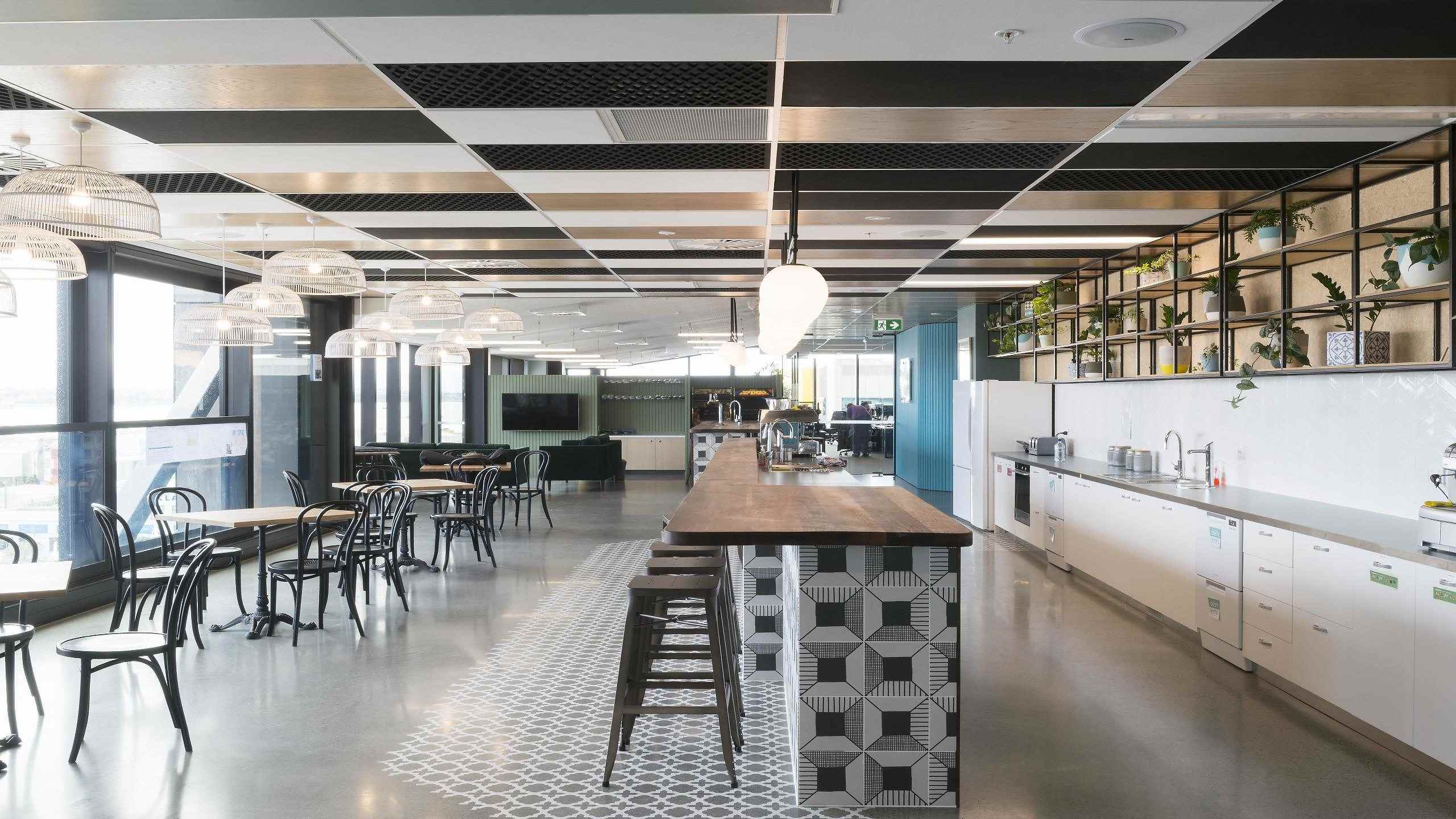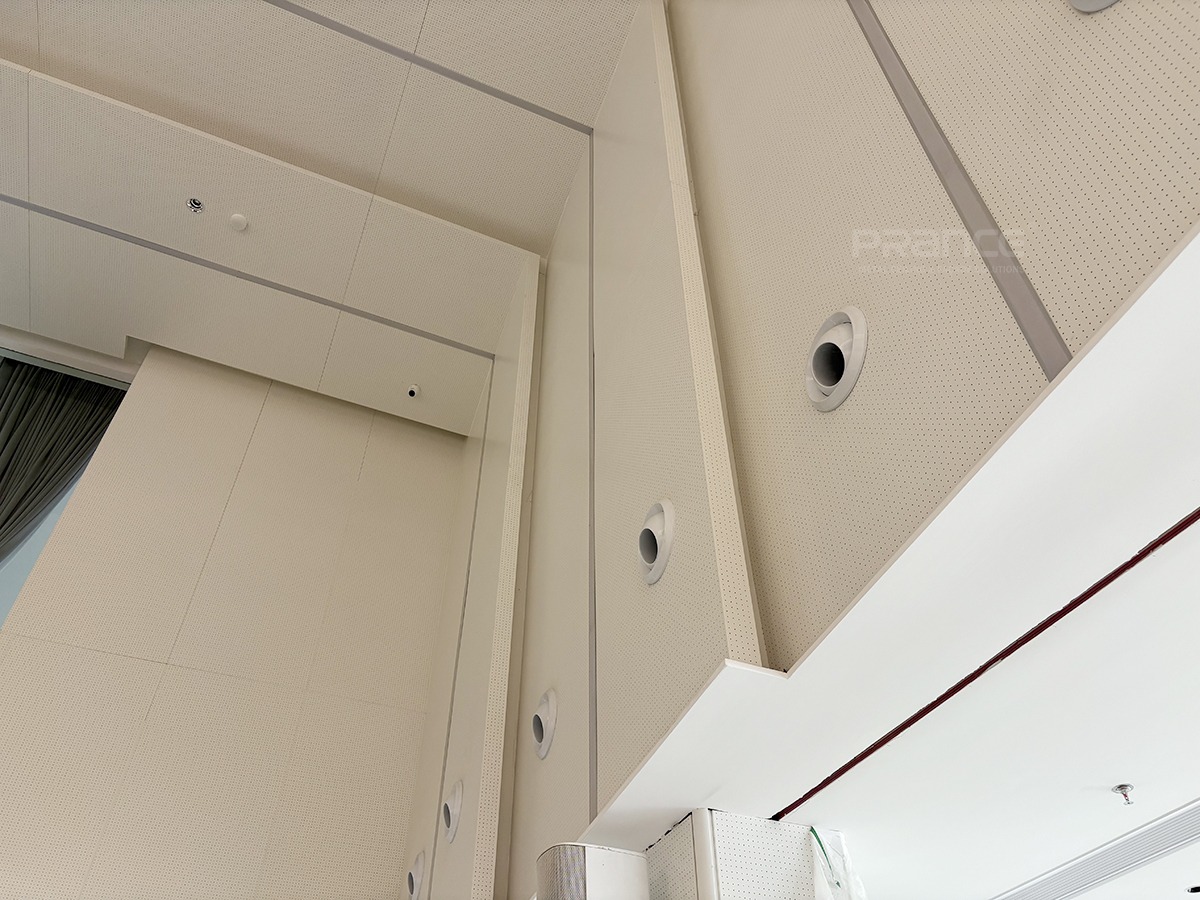PRANCE metalwork es un fabricante líder de sistemas metálicos para techos y fachadas.
A Step-by-Step Guide to Designing Commercial Spaces with Acoustic Ceiling Tiles
Imagine llegar a un edificio de oficinas o al vestíbulo de un hotel concurrido. La cacofonía puede ser una distracción, excesiva e incluso estresante. Aquí es donde se encuentran las placas acústicas para techo. Encuentra aplicaciones. Arquitectos, constructores y diseñadores que trabajan en proyectos comerciales recurren a estas placas no solo por su valor práctico, sino también por su atractivo estético. Desde mejorar la gestión del sonido hasta añadir un estilo elegante y moderno, las placas acústicas para techos son esenciales para crear entornos cómodos y eficaces.
En esta guía completa, le explicaremos los procesos para integrar eficazmente paneles acústicos en su edificio comercial. Ya sea propietario, contratista o diseñador, este libro le guiará en cada etapa para garantizar que su proyecto cumpla con los criterios estéticos y prácticos.
Paso 1: Comprensión de las placas de techo acústicas
Comprender qué son las placas de techo acústicas y por qué son importantes en entornos comerciales ayudará a uno a abordar el diseño con conocimiento.
¿Qué son las placas de techo acústicas?
Los paneles acústicos para techos son paneles diseñados específicamente para controlar el ruido ambiental. Generalmente compuestos de materiales como aluminio perforado o acero inoxidable, estos paneles absorben y reducen las reflexiones sonoras mediante capas aislantes como la lana de roca.
Beneficios de los paneles acústicos para techos
- Reducción de eco y claridad: las placas de techo acústicas pueden alcanzar valores NRC de 0,6 a 0,8 , lo que mejora la inteligibilidad del habla en oficinas, salas de conferencias y hospitales.
- Estética profesional: otorgan a los techos un aspecto ordenado y profesional y pueden complementar el diseño interior comercial moderno.
- Fuego, humedad y durabilidad: muchas baldosas tienen clasificación de resistencia al fuego Clase A (ASTM E119) y son resistentes a la humedad y al desgaste, adecuadas para áreas de alto tráfico.
- Diseño personalizable : personalizable para adaptarse a los requisitos de diseño, viene en varios tamaños, patrones y acabados.
Paso 2: Identificar los requisitos de su espacio
Cada iniciativa empresarial tiene requisitos específicos. Analice las necesidades específicas de su espacio antes de elegir los materiales o la distribución.
Evaluación de los requisitos de audio
- Áreas de absorción de alta prioridad : Bibliotecas, hospitales y salas de conferencias suelen requerir una alta absorción acústica. Un valor objetivo de NRC (coeficiente de reducción de ruido) de 0,7 a 0,8 puede ayudar a lograr una voz clara y reducir el eco.
- Áreas de absorción moderada : vestíbulos, pasillos y áreas de espera pueden requerir solo un control acústico modesto.
- Salas especializadas : Espacios como cafeterías o salas multiusos tienen necesidades acústicas diferentes a las de oficinas o salas de reuniones. Considere el ruido de la actividad humana, la maquinaria o fuentes externas al planificar.
Entendiendo los objetivos estéticos
Combine la decoración general del edificio con el diseño de las placas del techo. Si bien los patrones perforados pueden aportar profundidad a vestíbulos amplios, los elegantes acabados metálicos se integran a la perfección en entornos de oficina contemporáneos.
Paso 3: Planificación del diseño y la disposición
Un techo bien diseñado garantiza tanto atractivo visual como el mejor rendimiento. Este es el enfoque.
1. Determinación de sistemas de red
Elija la rejilla adecuada: La mayoría de los paneles de techo acústicos se adaptan a un sistema de rejilla, ya sea de perfil en T o de suspensión. Elija uno según:
La altura del techo es importante: los techos más altos podrían requerir sistemas suspendidos para simplificar la instalación y el mantenimiento.
Acceso a servicios públicos: Asegúrese de que la red permita un fácil acceso a la climatización, el cableado eléctrico y los rociadores. Una planificación adecuada evita costosos ajustes posteriores.
2. Posición y patrón de las baldosas
Simetría para profesionalismo : alinee las baldosas de manera uniforme para crear una apariencia cohesiva y pulida.
Integración de iluminación : planifique que las luminarias se combinen perfectamente sin interrumpir el rendimiento acústico.
Alineación de las rejillas de ventilación: mantenga las rejillas de ventilación del sistema HVAC alineadas con la rejilla para mantener el flujo de aire y optimizar la comodidad.
Paso 4: Elegir las placas acústicas adecuadas para el techo

El propósito y el diseño de las baldosas ayudarán a elegir las correctas. Recuerda estos elementos:
1. Consideraciones materiales
Azulejos de aluminio : Ligeros, resistentes a la corrosión, ideales para áreas húmedas como cocinas y hospitales.
Azulejos de acero inoxidable : fuertes, resistentes al fuego, perfectos para espacios de alto tráfico como vestíbulos o aeropuertos.
Azulejos de titanio : excelente relación resistencia-peso, larga duración, adecuados para entornos de lujo o especiales.
2. Rendimiento acústico
Para determinar la eficacia de la baldosa para absorber el sonido, verifique el valor del Coeficiente de Reducción de Ruido (NRC). Una mayor absorción acústica se obtiene a partir de valores NRC más altos.
3. Opciones de diseño
Perforaciones: Mejoran tanto el atractivo visual como la absorción del sonido.
Acabados: Desde brillo metálico hasta texturas cepilladas, combine las baldosas con el diseño de las baldosas del techo y el estilo interior general.
Personalización: para proyectos comerciales, seleccione placas de techo acústicas personalizadas para integrar la marca y la iluminación a la perfección.
Paso 5: Proceso de instalación
Una buena instalación garantiza que las baldosas permanezcan firmemente en su lugar y se comporten como se espera.
1. Preparando el espacio
- Mida con cuidado para asegurarse de que la cuadrícula se alinee con las dimensiones de la habitación. Verifique las medidas para evitar espacios o desalineaciones.
- Inspeccione las placas del techo acústico para detectar daños o superficies irregulares; repárelas según sea necesario para mantener la estabilidad.
- Planifique el acceso a servicios públicos como rociadores, respiraderos de HVAC e iluminación para facilitar el mantenimiento futuro.
2. Instalación del sistema de red
- Siga de cerca el patrón de la cuadrícula del techo y fíjelo de forma segura a las vigas.
- Utilice cables o varillas de suspensión, comprobando la nivelación con un nivel de burbuja o láser (se recomienda una tolerancia de ±2 mm).
- Asegurarse de tener una rejilla estable evita que las baldosas se hundan y queden desniveladas en su sistema de techo suspendido.
3. Colocación de las placas acústicas del techo
- Deslice las baldosas suavemente en la rejilla para evitar rayones y mantener el acabado.
- Agregue aislamiento como lana de roca detrás de las baldosas si se requiere una mayor absorción del sonido.
- Recorte las baldosas con precisión alrededor de las rejillas de ventilación o los accesorios para lograr una apariencia limpia y profesional.
Paso 6: Evaluación del rendimiento después de la instalación
Revise el área después de la instalación para asegurarse de que las placas del techo acústico cumplan con sus expectativas.
1. Pruebas acústicas
- Reproduzca música, hable o aplauda para identificar ecos y la claridad del sonido.
- Utilice medidores de decibelios para medir la absorción acústica en equipos especializados.
2. Revisión visual
- Asegúrese de que cada mosaico quede alineado dentro de la cuadrícula.
- Compruebe si hay rayones, desalineación o daños menores; una rejilla bien alineada evita que se hunda y que el sonido se distribuya de forma desigual.
3. Planes de mantenimiento
Crea un calendario de mantenimiento para mantener las baldosas en buen estado y limpias. Para conservar su acabado, las baldosas metálicas solo necesitan una limpieza básica con herramientas no abrasivas.
Paso 7: Añadiendo los toques finales
Agregar acentos de acabado para personalizar el lugar puede mejorar su atractivo.
Mejora de la iluminación
Agregue dimensión al diseño del techo y acentúe áreas específicas con iluminación empotrada o en riel. En los techos acústicos metálicos reflectantes, la reflectancia lumínica (LR) puede alcanzar entre 0,7 y 0,8, lo que mejora la distribución de la luz natural y reduce el deslumbramiento en espacios comerciales.
Elementos de marca
Para acentuar la identidad del espacio comercial, considere incluir los colores o emblemas de la marca en el diseño del techo. La integración de colores y patrones puede fortalecer el reconocimiento de la marca y crear una experiencia memorable para los visitantes.
Complementos funcionales
Instale paneles de pared o barreras acústicas en habitaciones que requieran mayor control del ruido. El uso de placas decorativas para techos comerciales con valores altos de NRC (Coeficiente de Reducción de Ruido) de 0,6 a 0,8 puede mejorar significativamente el confort acústico en oficinas, vestíbulos o restaurantes.
Conclusión
El diseño moderno de espacios corporativos se centra principalmente en los paneles acústicos para techos. Controlan el sonido, mejoran la apariencia y ayudan a crear entornos más agradables y funcionales. Estos paneles ofrecen una solución flexible que se adapta a sus necesidades, ya sea la remodelación de un hospital, la actualización del vestíbulo de un hotel o el amueblamiento de un nuevo espacio de trabajo. Seguir estas pautas le ayudará a crear un entorno estéticamente agradable y acústicamente óptimo.
¿Busca soluciones acústicas de alta calidad para optimizar sus proyectos comerciales? Contacte con PRANCE Metalwork Building Material Co. Ltd para descubrir diseños de techos elegantes y robustos, diseñados para la máxima calidad.
5 preguntas frecuentes sobre placas acústicas para techos
P1. ¿Cuáles son los principales beneficios de utilizar paneles acústicos para techos suspendidos en espacios comerciales?
Las placas acústicas para techos ayudan a controlar el eco, mejoran la claridad y la comodidad en oficinas, hoteles y restaurantes. Estas placas acústicas comerciales también ofrecen una apariencia elegante y son resistentes al fuego y a la humedad.
P2. ¿Son los paneles acústicos negros para techo tan eficaces como los blancos estándar para controlar el ruido?
Sí. Los paneles acústicos negros para techos ofrecen la misma absorción acústica NRC que los paneles blancos, a la vez que reducen la reflexión de la luz. Son ideales para teatros, estudios y restaurantes que necesitan control acústico y una profundidad visual moderna.
P3. ¿Qué debo saber antes de instalar paneles acústicos para techo?
Antes de instalar paneles acústicos para techo, asegúrese de que el sistema de perfilería esté nivelado y permita el acceso a la iluminación o el sistema de climatización. Utilice un aislamiento adecuado detrás de los paneles para una mejor absorción del ruido, especialmente en salas de reuniones o vestíbulos.
P4. ¿Qué impacto tienen las placas acústicas decorativas en los techos en los interiores comerciales?
Los paneles acústicos decorativos para techos realzan el estilo interior a la vez que controlan el sonido. Sus texturas y acabados crean un atractivo visual en vestíbulos y áreas comerciales, equilibrando la funcionalidad con la estética del diseño.
Q5.¿Cómo puedo elegir las placas de techo acústicas comerciales adecuadas para mi proyecto?
La selección de placas acústicas para techos comerciales depende del nivel de ruido de su espacio, el acabado deseado y las necesidades de mantenimiento. Las placas metálicas son ideales para oficinas por su durabilidad, mientras que los paneles de alto NRC mejoran la comodidad en restaurantes y salones. Contacte con los expertos de PRANCE para obtener asesoramiento personalizado sobre cómo elegir la solución de techo acústico ideal para su proyecto comercial.






















